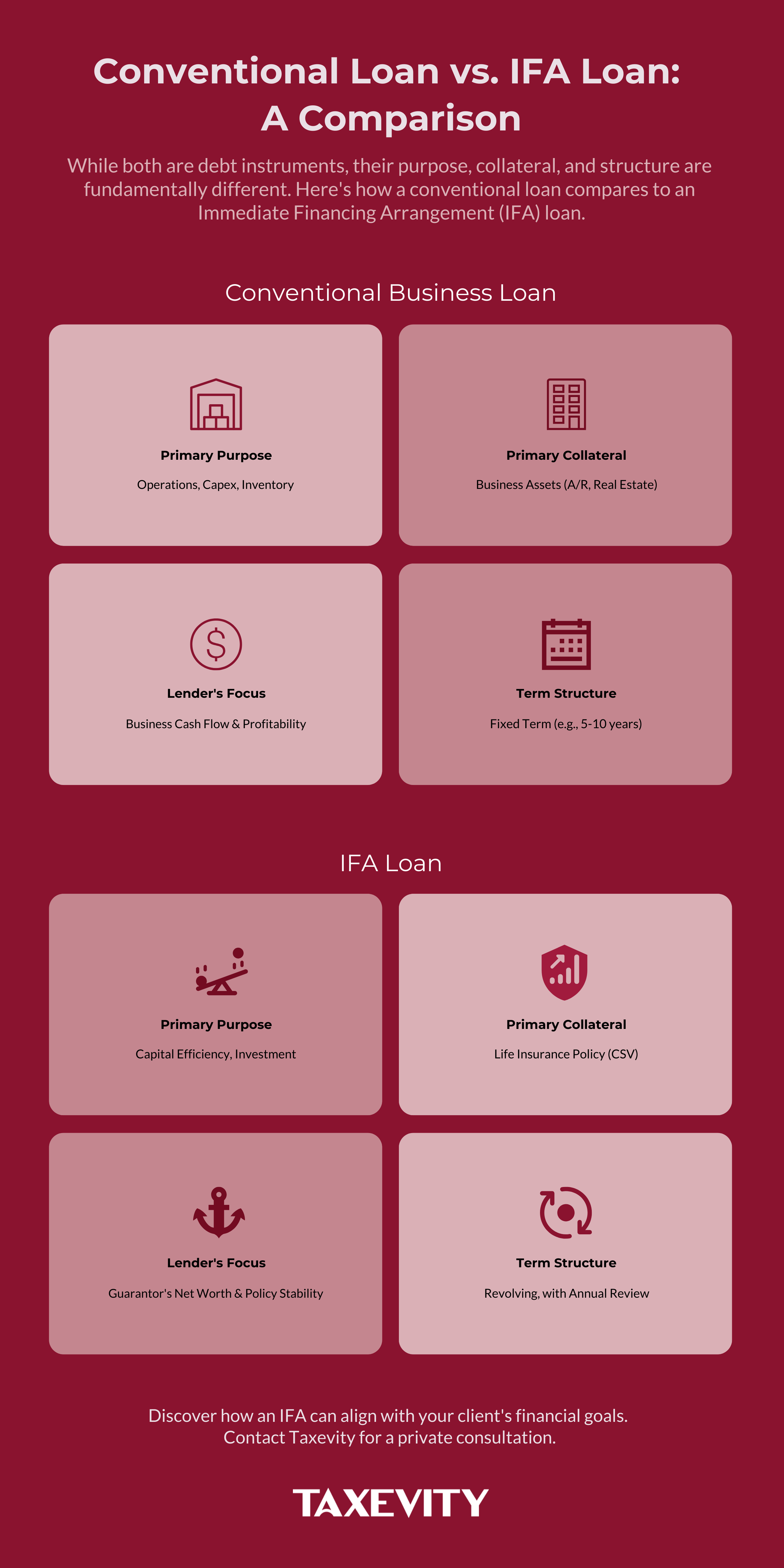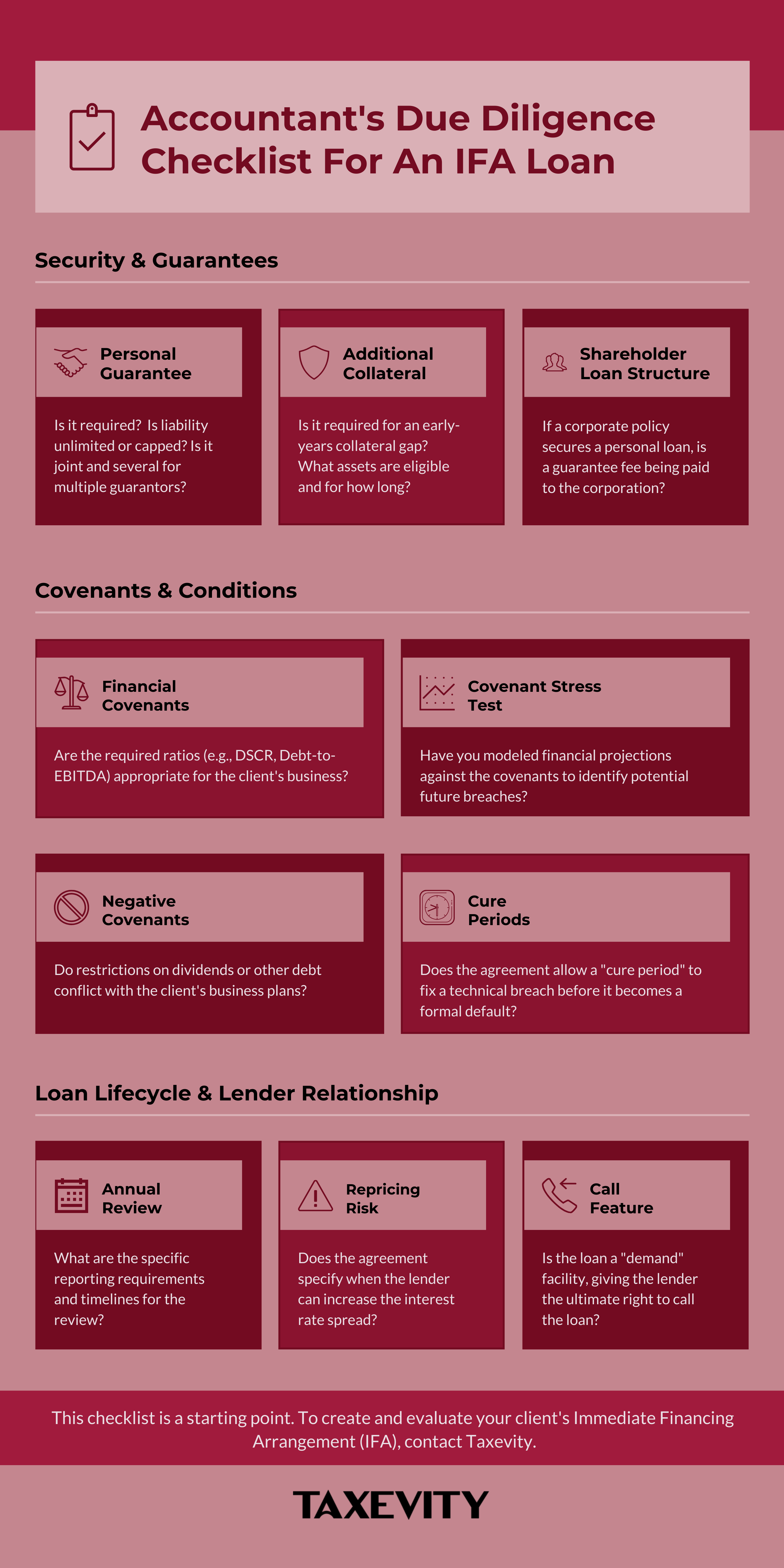(Part of the IFA Master Curriculum)
Key Question for Accountants
As an accountant, how do you protect your client from the long-term risks embedded in the loan agreement for an Immediate Financing Arrangement (IFA)?
- The Hidden Risk: Your due diligence must account for the lender’s full security package, particularly the personal guarantee that makes the principal shareholder personally responsible for the corporation’s debt, placing their personal assets at risk.
- The Strategic Analysis: You must deconstruct the web of loan covenants and stress-test them against the client’s financial projections to identify potential future breaches and avoid a technical default.
- The Tangible Outcome: This critical oversight transforms the loan agreement from a source of hidden risk into a manageable component of a powerful financial strategy, reinforcing your role as a key and trusted advisor.
While the strategic merits of an Immediate Financing Arrangement (IFA)—namely financial protection, capital efficiency and tax-advantaged growth—are compelling, the success of this multi-decade strategy hinges on the fineprint within its single most critical component: the loan agreement. For an accountant, dissecting the legal anatomy of the credit facility is an essential part of due diligence.
The IFA loan is defined by a fundamental duality: it underpins a financial plan designed to last for life, yet it’s contractually structured as a short-term, revolving line of credit that the lender re-evaluates annually. This mismatch between the client’s long-term strategic horizon and the lender’s short-term contractual commitment is a primary source of risk that must be understood and managed.
This guide deconstructs the IFA loan agreement to provide a balanced, clear-eyed view of the legal rights, obligations, and risks inherent in the structure. We will move beyond the basics of collateral and look into the key areas that define the true power dynamic between your client and the lender.
Page Contents
- 1 1. The Lender’s Perspective: Why an IFA Loan is a Stable, Attractive Asset
- 2 2. How an IFA Loan Compares to a Conventional Business Loan
- 3 3. Deconstructing the Full Security Package
- 4 4. The Web of Covenants: The Rules of the Road
- 5 5. The Annual Review: A Relationship Check-up
- 6 6. A Prudent Strategy: Comparing Lenders and Terms
- 7 7. Accountant’s Due Diligence Checklist for an IFA Loan
- 8 Conclusion: Your Role as the Guardian of the Agreement
1. The Lender’s Perspective: Why an IFA Loan is a Stable, Attractive Asset
Before examining the risks to the borrower, it’s crucial to understand why lenders are comfortable with these arrangements. An IFA loan is not a speculative venture for a lender; it is a highly secure, long-term revenue stream anchored by superior collateral.
A participating whole life insurance policy is an exceptionally high-quality asset for a lender. Unlike a stock portfolio, its value is not subject to daily market volatility. The policy’s Cash Surrender Value (CSV) has a contractually guaranteed floor and is projected to grow predictably over time. This stability is why lenders are willing to offer high loan-to-value ratios—often up to 100% of the CSV—and why a specialized market of both bank and non-bank lenders exists for this purpose. From the lender’s viewpoint, IFA loans are built on a foundation of low-risk collateral and a high-net-worth client base.
2. How an IFA Loan Compares to a Conventional Business Loan

For a business owner, it’s helpful to contrast an IFA loan with a conventional term loan or operating line of credit. While both are debt instruments, their purpose, collateral, and structure are fundamentally different. An IFA allows a client to leverage a personal/corporate asset for investment without encumbering the operating assets of their business.
| Feature | Conventional Business Loan | IFA Loan |
|---|---|---|
| Primary Purpose | Operations, Capital Expenditures, Inventory | Capital Efficiency, Investment |
| Primary Collateral | Business Assets (Accounts Receivable, Real Estate) | Life Insurance Policy cash surrender value (CSV) |
| Lender’s Focus | Business Cash Flow & Profitability | Guarantor’s Net Worth & Policy Stability |
| Term Structure | Fixed Term (e.g., 5-10 years) | Revolving, with Annual Review |
3. Deconstructing the Full Security Package
While the life insurance policy is the foundational pillar of security, the full security package often extends far beyond the policy itself, creating a robust safety net for the lender.
Personal Guarantees: Piercing the Corporate Veil
When a corporation takes out an IFA loan, it is standard practice for the lender to require a personal guarantee from the principal shareholders. This legally binding contract makes the individual personally responsible for the corporation’s debt if it defaults. This instrument effectively pierces the corporate veil of limited liability, placing the shareholder’s personal assets—including their home, non-registered savings and investments, and other valuable property—at risk.
A significant tax risk arises when a corporate-owned policy is used to secure a personal loan for a shareholder. The Canada Revenue Agency (CRA) can view this as the corporation conferring a taxable benefit on the shareholder. To mitigate this, the established best practice is for the shareholder to pay the corporation an annual guarantee fee, typically in the range of 1% to 3% of the outstanding loan balance. This is usually not an issue with IFAs, as they function best when the owner and borrower are the same entity to maximize deductions, so most corporately structured IFAs won’t have personal loans involved.
Managing the “Collateral Gap”
A common structural challenge in the early years of an IFA is the “collateral gap”, where cumulative premiums paid exceed the policy’s CSV. To bridge this shortfall, lenders traditionally require the borrower to post additional collateral (e.g., cash or liquid investments). However, the market is evolving. Some lenders, often in exchange for a higher interest rate, now offer loans of 100% of the premium without requiring additional collateral.
4. The Web of Covenants: The Rules of the Road
The IFA loan agreement contains a series of covenants—binding promises and restrictions—that govern the borrower’s conduct. While they can feel restrictive, their primary purpose is to act as an early warning system to keep the strategy on track.
- Affirmative Covenants (Obligations): These clauses obligate the borrower to perform specific actions, such as providing annual financial statements, paying all taxes on time, and keeping all required insurance in force.
- Negative Covenants (Restrictions): These prohibit the borrower from taking certain actions without the lender’s consent, and may include forbid incurring additional debt, selling major business assets, or paying dividends if financial targets aren’t being met.
- Financial Covenants (Performance Ratios): These are specific, numerical tests that must be met, such as maintaining a certain Debt Service Coverage Ratio (e.g., ensuring cash flow is at least 1.25 times all debt payments) or a maximum Leverage Ratio. A breach is a clear event of default, even if the borrower has never missed an interest payment.
To make this tangible, consider “ABC Holdings Inc”, a profitable company undertaking an IFA. A covenant requires their Debt-to-EBITDA ratio to remain below 3.0x. A planned acquisition would push this to 3.5x. As their accountant, you would flag this, prompting a proactive discussion with the lender to seek a temporary waiver before the acquisition closes, thereby avoiding a technical default.
5. The Annual Review: A Relationship Check-up
The annual review process is the central mechanism through which the lender manages its long-term risk. For a performing client with strong financials, the annual review is typically a formality. However, the lender retains the unilateral right to change the terms of the facility. Potential changes include:
- Repricing the Loan: Increasing the interest rate spread over prime.
- Adjusting the Lending Margin: Reducing the loan-to-value (LTV) ratio.
- Requiring Additional Collateral: Demanding the borrower pledge more assets if the policy’s value has underperformed. This is a key reason why Taxevity’s IFA projections use dividend scales that are lower than what the insurer is currently paying, as this precaution helps to build a buffer against this risk.
The most severe risk is the lender’s decision not to renew the facility or to exercise its right to call the loan. While this right is absolute, it is a lender’s last resort, typically triggered only by a serious default.
6. A Prudent Strategy: Comparing Lenders and Terms
IFA loans differ. A prudent due diligence process, guided by the advisory team, involves contacting different lenders—both major banks and specialized non-bank lenders—to compare their offerings. The focus should extend beyond the headline interest rate to a careful review of the loan terms:
- How flexible are the covenants?
- What are the fees for setup and annual reviews?
- Does the lender require personal guarantees and additional collateral, or do they offer alternatives?
- What is the lender’s long-term commitment to the IFA market? A lender who specializes in this area may offer more stability than one for whom it is a peripheral business line.
This comparative analysis allows the client to choose a lending partner whose terms and risk philosophy best align with their own.
7. Accountant’s Due Diligence Checklist for an IFA Loan
This checklist summarizes the key points from this guide into an actionable tool for reviewing a proposed IFA loan agreement.

Security & Guarantees
- Personal Guarantee: Is it required? Is liability unlimited, or can it be capped? If there are multiple guarantors, is the liability joint and several?
- Additional Collateral: Is it required to cover an early-years collateral gap? If so, what assets are eligible, and for how long will they be pledged?
- Shareholder Loan Structure: If the loan is personal but secured by a corporate policy, is a reasonable guarantee fee being paid to the corporation to mitigate shareholder benefit risk?
Covenants & Conditions
- Financial Covenants: Are the required ratios (e.g., DSCR, Debt-to-EBITDA) appropriate for the client’s industry and business cycle?
- Covenant Stress Test: Have you modeled the client’s financial projections against the covenants to identify potential future breaches?
- Negative Covenants: Do any restrictions (e.g., on paying dividends, taking on other debt) conflict with the client’s near-term business plans?
- Cure Periods: Does the agreement allow for a “cure period” (e.g., 30 days) to rectify a technical breach before it becomes a formal Event of Default?
Loan Lifecycle & Lender Relationship
- Annual Review: What are the specific reporting requirements and timelines for the annual review?
- Repricing Risk: Does the agreement specify the conditions under which the lender can increase the interest rate spread over prime?
- Call Feature: Is the loan structured as a “demand” facility, giving the lender the ultimate right to call the loan?
Conclusion: Your Role as the Guardian of the Agreement
An IFA requires a coordinated team of independent experts. While the client’s lawyer reviews the loan agreement for legal integrity, Taxevity structures the foundational insurance asset, and the wealth advisor manages the investment of the borrowed funds, your role as the accountant is to be the guardian of the strategy’s ongoing financial health.
The risks within the loan agreement are real, but they must be weighed against the risks of the status quo: leaving a major estate liability unfunded, or immobilizing significant capital that could be used for growth. By dissecting the terms, stress-testing the covenants, and guiding your client to understand the nature of the lender relationship, you provide the critical oversight needed. Your diligence transforms the loan agreement from a source of hidden risk into a manageable component of a powerful financial strategy, reinforcing your role as a key and trusted advisor.
If you are reviewing an IFA loan agreement for a client and would like a second opinion on its terms and risks, we can help. We can review the proposal, identify areas that may require more scrutiny, and help you formulate key questions for the other advisors. Contact Taxevity to start the conversation.





